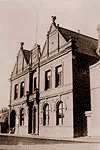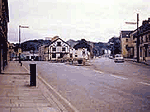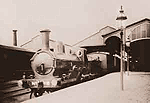Roots in Ireland
Jean Crawford, granddaughter of Sally Liggett Best (one of twins born to William John and Mary Liggett in 1872) lives about seventy miles from an old Liggett homestead area of Portadown, Ireland. (See Jean above in 1953: second row from bottom, second from right.) Jean has a costume shop with her daughter, Lorraine. Her granddaughter, Kirstie, is pictured above in one of their custom costumes. When Jean was a child, she would sit on the stairs and listen to the family yarning (going over memories). She has the family gift for storytelling and has shared some of her yarns about the Liggetts.
“The Liggetts are known as the ‘Fighting Liggetts,’ because it is said they would start a fight in an empty house. Blonde and blue-eyed, one named Joe was known as the white haired boy. Sally became pregnant by a farmer’s son. For some reason or other they did not marry. However on the day they went to court (pictured below) to settle maintenance all the Liggets went to the court too. The judge told Sally and the child’s father to stand together in the dock. Sally had the child in her arms. The child reached out to its father and said ‘Da Da.’ The judge said, ‘the child knows its own, pay half a crown a week.’ The Liggets tried to lynch the baby’s father and there was a riot in the court. They all ended up being arrested. Later on Sally’s father tried to assassinate the man who had taken his daughter down. That’s the Liggets for you!”
“Sally was a damask linen weaver, an elite in her trade, as it was the finest quality and had a design woven into it.” She left Jean’s mother, younger sister and brother, outside the school in the morning on her way to work at the factory. They had no shoes and had to stand and wait at least an hour for the school to open, winter or summer. Sally had no choice because she was a widow. There was no help for the poor. They survived or died in the workhouses. Jean’s mother began working in a linen factory when she was just nine years old and had to show proof of attending school two days a week to get her wages. “It is no wonder the Liggets left Ireland. It is to their credit that they did well when they arrived,” says Jean. Sally was a widow from her thirties and went blind in her fifties. Her house was down at the bottom of the street, pictured below, on the left-hand side. A car is just visible about her doorway.
“Next door to her were the mad sisters Doran. The bread man used to reach them their bread in a basket that was on the end of a pole and receive the payment the same way. They had a cat and every time they caught the cat they would pluck it (I kid you not). The poor cat ended up almost bald. Sadie, Jean’s cousin, lived in Granny Best’s house. One day Sadie was in the backyard singing. A penny came over the wall and a voice shouted, ‘Go to the next street.’ Sadie was mortified. She thought she had a lovely singing voice. So much for vanity.”
“Confined to her bed with cancer of the stomach, Sally refused to have surgery. She believed that surgery would shorten her life, so she suffered badly the last years of her life. When her twin sister, Liz, died first in Scotland, her ashes were brought home to Ireland and placed in Sally’s wardrobe. Then Liz’s husband died in Scotland and, as he wanted to be with his wife, his ashes also ended up in Sally’s wardrobe. Sally had the gift of fae (second sight).” Jean’s Aunt Sarah had a foster child named Rosaleen who knew of the caskets in the wardrobe. “So one day she brought a friend into Granny Best’s bedroom. She checked that Granny was asleep and lifted the casket out to show it to her friend. Granny sat up in the bed and looked straight at Rosaleen. ‘Leave my sister alone,’ she said to Rosaleen. Remember that Granny was stone blind. Rosaleen fled the bedroom and refused to go back for a long time. It seems that it was not the first time that Granny was able to tell when the casket was disturbed.”
Sally died in her house on David Street in 1952 at age 80. “When the cortege arrived in Seagoe graveyard, the preacher was waiting to conduct the internment service. Then to his horror he spotted two additional caskets containing Sally’s sister and husband. He refused to conduct the service saying he was only there for one internment. However, he was over ruled when the family put the two caskets on top of Sally’s coffin. So typical Ligget style, the family got three burials for the price of one.”
Jean was one of 14 children born on Henry Street (above) in the house where the car is. These houses were built for weavers who worked at the factories and have since been torn down. They had walled yards to the rear with two rooms upstairs and two rooms and a scullery downstairs. Jean’s mother passed away in 1999 at the age of 94. She went blind as her mother did before her.
“Ellis’s Pub in Edenderry (black and white building above),” says Jean, “is the Liggett stronghold, and watering hold if you get my meaning. The old railway station was right on their doorsteps. Picture in your mind a small old lady. A long skirt, shawl draped over her head, and around her shoulders: this was Aunt Mary Alice Liggett. She carried a large bunch of keys. If she came across a drunken fight she hit the nearest man on the head with the keys and sent him kicking as my mother would say. This ended the fight and Mary Alice would enter her home on Foundry Street and lock the door behind her. She was addicted to snuff. One night my grandmother Sally was dying, and as was the custom, the family gathered. The bawnshee was heard crying. ‘That’s it come for Sally,’ said Mary Alice. She went home to her house, and when she did not appear the next day, someone went to see how she was. Mary Alice was dead. The bawnshee had come for her and not for Sally.” Mary Alice’s house resided in the vicinity of Bridge and Foundry Streets pictured below.
St. Cobhans Church on Seagoe Road is where later generations of Liggetts have married and christened their children. Jean’s parents, brothers, sister, and grandmother Sally Liggett, as well as, her aunts and uncles are buried in the cemetery across the street, just beyond the cottage on the left side of this picture:
Jean also says, “What about the donkey race. You can bet there were Liggets on those donkeys. The donkey races were an annual event held on the main street. You haven’t laughed until you see a donkey race. They shed their riders and go everywhere but where they are led. They run into the spectators, turn and go back the way they came. It is hilarious. They are no longer used as means of transport. They are kept more as pets and companions for horses. A horse on its own in a field would be lonely. So they would put in a donkey to keep the horse happy.”










